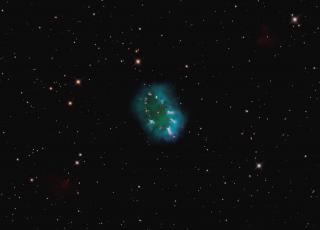Bibcode
Witham, A. R.; Knigge, C.; Drew, J. E.; Greimel, R.; Steeghs, D.; Gänsicke, B. T.; Groot, P. J.; Mampaso, A.
Referencia bibliográfica
Monthly Notices of the Royal Astronomical Society, Volume 384, Issue 4, pp. 1277-1288.
Fecha de publicación:
3
2008
Número de citas
105
Número de citas referidas
92
Descripción
We present a catalogue of point-source Hα emission-line objects
selected from the INT/WFC Photometric Hα Survey (IPHAS) of the
northern Galactic plane. The catalogue covers the magnitude range 13
<= r' <= 19.5 and includes Northern hemisphere sources in the
Galactic latitude range -5° < b < 5°. It is derived from
~1500 deg2 worth of imaging data, which represents 80 per
cent of the final IPHAS survey area. The electronic version of the
catalogue will be updated once the full survey data become available. In
total, the present catalogue contains 4853 point sources that exhibit
strong photometric evidence for Hα emission. We have so far
analysed spectra for ~300 of these sources, confirming more than 95 per
cent of them as genuine emission-line stars. A wide range of stellar
populations are represented in the catalogue, including early-type
emission-line stars, active late-type stars, interacting binaries, young
stellar objects and compact nebulae.
The spatial distribution of catalogue objects shows overdensities near
sites of recent or current star formation, as well as possible evidence
for the warp of the Galactic plane. Photometrically, the incidence of
Hα emission is bimodally distributed in (r' - i'). The blue peak
is made up mostly of early-type emission-line stars, whereas the red
peak may signal an increasing contribution from other objects, such as
young/active low-mass stars. We have cross-matched our Hα-excess
catalogue against the emission-line star catalogue of Kohoutek &
Wehmeyer, as well as against sources in SIMBAD. We find that fewer than
10 per cent of our sources can be matched to known objects of any type.
Thus IPHAS is uncovering an order of magnitude more faint (r' > 13)
emission-line objects than were previously known in the Milky Way.
Proyectos relacionados

Nebulosas Bipolares
Nuestro proyecto persigue tres objetivos principales: 1) Determinar las condiciones físico-químicas de las nebulosas planetarias con geometría bipolar y de las nebulosas alrededor de estrellas simbióticas. El fin es entender el origen de la bipolaridad y poner a prueba los modelos teóricos que intentan explicar la morfología y la cinemática nebular
Antonio
Mampaso Recio